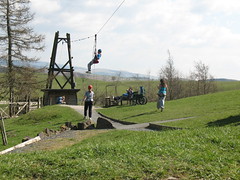Having hit my "tech high" in 2007, I have had time to be reflective of the current mass adoption and realization that tech (web 2.0) does matter for education. But when does it not matter? I'm on the other side now wondering how each tool and application can actually improve learning... and when do they impede individual growth? The following blog post from Dean Shareski articulates my latest thinking on schools and their ultimate purpose as these tools take over, or, as Harvard's Clayton M. Christensen says, "disrupt" our classrooms.
 Image by rockinpaddy via Flickr
Image by rockinpaddy via FlickrBut perhaps we don’t need every student to have a device? I’ve been arguing for a while that schools need to think much more closely at the wonderful gift they currently have of having students actually attend school in person. As online education grows so does the potential for students to opt out of face to face attendance. What will we offer our students in person that they can’t receive online? The answer is simple. Each other. I value the way we connect online but face to face is different and valuable. We need to be very careful that we aren’t trying to replicate the face to face experience online and vice versa.
One to one computing can still be a great thing but I’ve seen too many classrooms where students stare at screens. They can do at home. What they may not be able to do at home is sit with 2 or 3 classmates and design, talk, build and interact face to face. It’s hard to argue that somehow that’s not different. We’ve taken for granted forever that each day a bus will come by and drop off students at our buildings. We’ve not had to think critically about they way our classrooms and schools operate and so a conversation about what makes face to face special needs to occur.
Obviously access and computing needs to be part of the learning but we need to be careful about how we’re leveraging the experience of being together. In many cases the focus on computing might be outside of school as students create content, research and design. It may be the the classroom has a 2 to 1 ratio or 3 to 1 of devices as students do their research and designing collaboratively. Collaboration and interaction become the norm and not the exception. In this way, we acknowledge the wonderful human resource we have each day and design learning that truly takes advantage of our most important resource, each other.

Blended Learning models -
ReplyDeletehttp://www.innosightinstitute.org/innosight/wp-content/uploads/2011/05/The-Rise-of-K-12-Blended-Learning.pdf